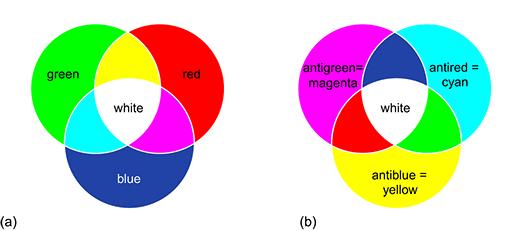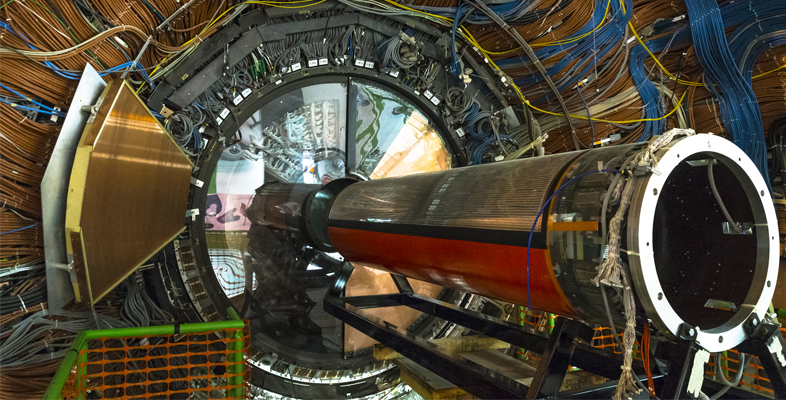6.2 Quantum chromodynamics
The quantum theory of the strong interactions between quarks and gluons is called quantum chromodynamics (QCD), always something impressive to drop into those dinner party conversations!
To understand why this theory is so called, you should note that ‘chromo’ comes from the Greek word for ‘colour’. The interactions between quarks and gluons are described in terms of a new property of matter that is called colour charge, by analogy with conventional electric charge.
Just as electromagnetic interactions result from forces between electrically-charged particles, so strong interactions result from forces between colour-charged particles. However, whereas conventional electric charge comes in only one type that can either be positive or negative, colour charge comes in three types, each of which can be ‘positive’ or ‘negative’.
These three types of positive colour charge are known as red, green and blue, and their negatives are antired (or the colour cyan), antigreen (or the colour magenta) and antiblue (or the colour yellow). Confusingly, it is important to disregard your ideas of colour and to note that colour charge has nothing to do with colours of light, it is merely a naming convention.
Each quark can have any one of the three colour charges, and each antiquark can have any one of the three anticolour charges. So in effect, there are three versions of each type of quark: red up quarks, blue up quarks and green up quarks, for instance.
Gluons each carry a combination of colour and anticolour charge (such as red–antiblue, blue–antigreen or green–antired), although they have zero electric charge. Leptons and photons do not have any colour charge associated with them. In all strong interactions there is therefore another conservation rule: colour charge is also conserved.
A red up quark emits a red-antiblue gluon. What colour charge does the up quark now have?
Since colour charge is conserved, the up quark must now have a blue colour charge.
A green down quark absorbs a blue-antigreen quark. What colour charge does the down quark now have?
Since colour charge is conserved, the down quark must now have a blue colour charge.
This model helps to explain many phenomena, such as why the only possible hadrons are baryons (consisting of three quarks), antibaryons (consisting of three antiquarks) and mesons (consisting of one quark and one antiquark).
Each of these composite particles has a net colour charge of zero. Any baryon must contain one quark with a red colour charge, one quark with a green colour charge, and one quark with a blue colour charge. By analogy with conventional colours: red + green + blue = white, a neutral colour with a net colour charge of zero. Likewise, antibaryons must contain one antiquark with an antired colour charge, one antiquark with an antigreen colour charge, and one antiquark with an antiblue colour charge. Again, this gives a net colour charge of zero.

Similarly, the quark–antiquark pairs that constitute a meson must have the opposite colour charge to each other: red + antired (cyan) = white for instance, which is a net colour charge of zero again.
Only particles with a net colour charge of zero are allowed to exist in an independent state, and this explains why single quarks and antiquarks are not seen in isolation. The locking up of quarks inside hadrons is referred to as confinement. Gluons do not have a net colour charge of zero either, so they too do not escape from strong interactions. Instead, gluons will decay into quark–antiquark pairs, which in turn create further hadrons.
